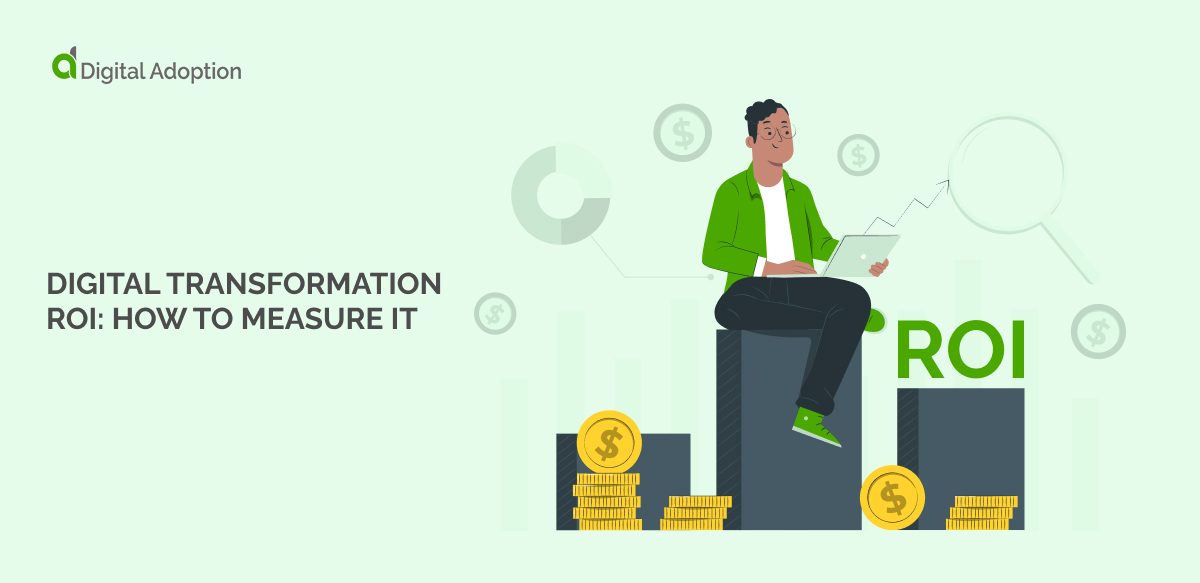The ubiquity of digital technologies has spurred the growth of digital transformation (DX) in almost every sector. According to Research and Markets, the Global Digital Transformation Market is predicted to grow rapidly by 2025, registering a Compound Annual Growth Rate of 16.5%. This impressive rate would generate an estimated USD 1,009.8 Billion in earnings – up from the current figure of USD 469.8 Billion.
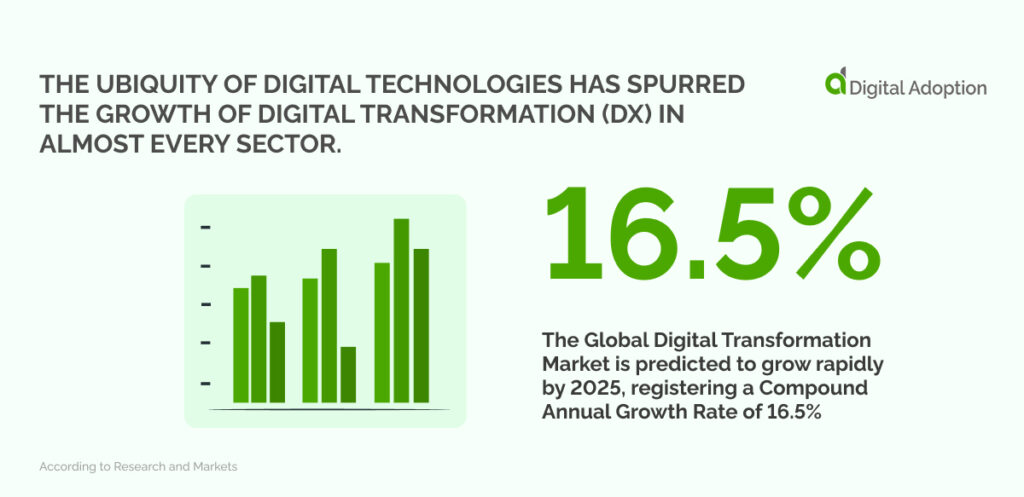
Digital transformation investments are increasing rapidly, yet organizations may see decreased ROI due to incompatibilities between goals, benefits, and anticipated outcomes. As organizations progress along their DX journey, each target will require a specific solution that strategizes digital technology investments. Keeping track of the ROI should be an ongoing activity to ensure that all investments made by the company yield worthwhile returns capable of increasing the bottom line.
A recent McKinsey Global Survey showed that ninety percent of C-level and senior leaders had pursued a digital transformation in the past two years. Although many organizations didn’t experience the desired outcome regarding revenue or costs, those considered “top economic performers” were much more likely to report value from their efforts.
This article examines the methods of measuring ROI from digital transformation. We discuss the tangible and intangible benefits businesses can gain from utilizing DT and analyze the most important factors affecting the ROI of digital transformations.
How to measure the ROI of Digital Transformation
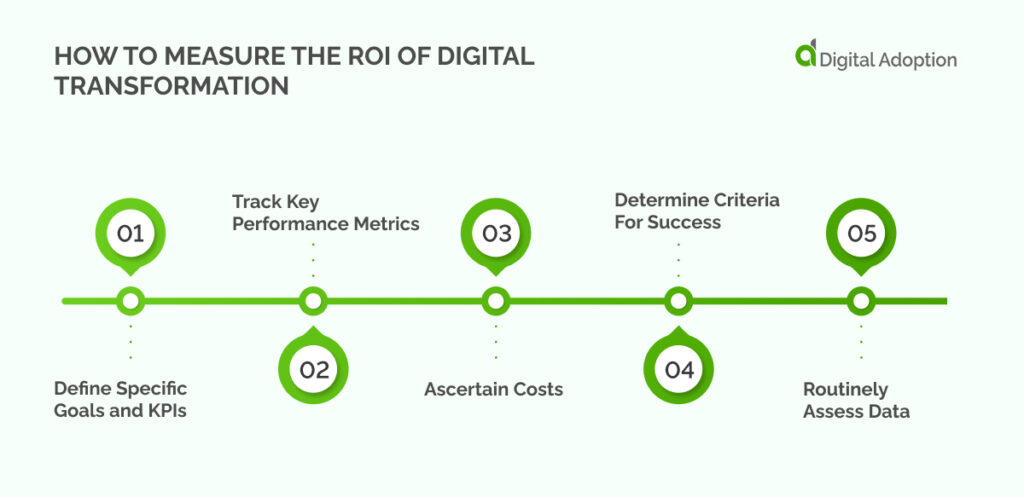
Every industry has unique workplace standards, philosophies, and objectives, and business leaders must consistently explore new and unique strategies for success.
Measuring digital transformation’s return on investment (ROI) is essential in determining whether or not the project is worth implementing. Keeping this in perspective, here are strategies to effectively measure the return on investment of digital transformation.
Define Specific Goals and KPIs
The first step is to define specific goals for the digital transformation project.
This will help ensure that CIOs are able to track progress and outcomes as they relate to actual performance indicators. It also allows stakeholders to clearly understand what success looks like, which can offer guidance across all project areas.
Track Key Performance Metrics
The second step is to track key performance metrics throughout the project’s lifetime. This could include collecting data points such as sales and customer satisfaction ratings or any other number associated with achieving goals.
It is important to identify key stakeholders involved in transition planning, implementation, and maintenance stages and involve them in measuring ROI at each stage. This ensures that everyone remains informed about successes and challenges faced along the way.
Ascertain Costs
Business leaders and CIOs should calculate all costs of launching and supporting digital transformation projects.
This should include both time invested by employees involved and money spent on tools or resources needed for the successful execution of the project. A comprehensive calculation upfront allows more accurate budgeting for future investments if needed and measures how much has been saved over time compared to manual processes.
Determine Criteria For Success
It’s also recommended that business leaders outline success criteria for their digital transformation projects before investing time and resources into it.
Establishing measurable goals before launch makes it easier to monitor progress and measure ROI much later down the line when evaluating results obtained from executing said strategies effectively.
Monitoring measurements regularly throughout the project timeline to adjust or revise goals if necessary based on newer insights gained along the way is another nessecasary measure.
Routinely Assess Data
Evaluate results accurately after completion by checking that accurate data points support any new measures before making decisions based on their accuracy – helping avoid potential loss due to incorrect interpretations later down the line if unchecked initially.
Analyzing the Important Factors that Affect ROI of Digital Transformations

Digital transformation is an important but costly endeavor for companies. To ensure that the investment pays off, organizations must consider key factors influencing return on investment (ROI). These include the cost of implementation, the amount of training needed, and the impact on company processes. Understanding these can help organizations make informed decisions and maximize their return from digital transformation projects.
Based on insights from Prophet, companies perceive digital transformation as a cost center (28%), and data that would prove its ROI remains hard to obtain (29%).
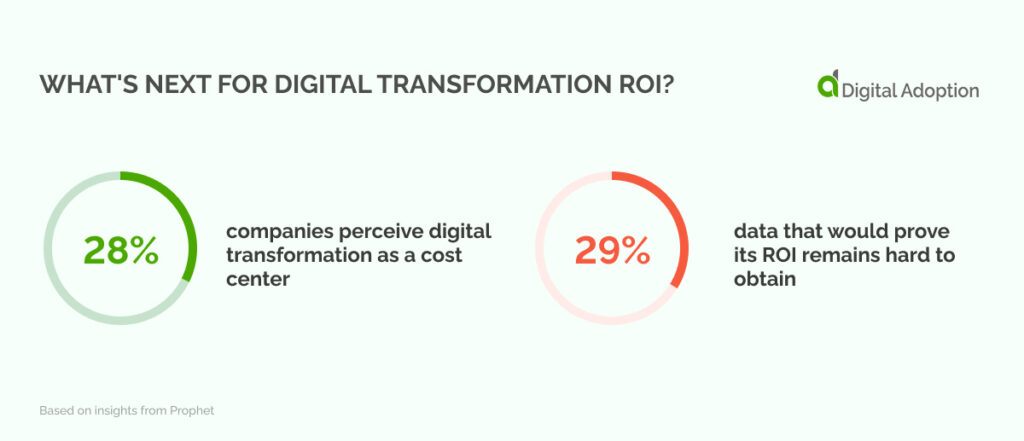
Organizations should begin by assessing their current structure and processes. This can help identify any shortcomings or weak spots in existing systems that could benefit from digital transformation. For example, inefficient manual processes may be replaced with automated solutions that can increase speed and reduce costs. Organizations should also consider hiring employees with expertise in digital transformation to develop custom solutions tailored to their unique needs.
The cost of implementation is another factor to consider when evaluating ROI for a digital transformation project. This includes the up-front expenses associated with purchasing hardware and software and ongoing expenses such as licensing fees and maintenance costs. Organizations must accurately assess these costs versus the estimated returns to determine whether the project is viable.
Organizations must also consider training costs when evaluating ROI for digital transformation projects. Employees need to learn how to use new systems and tools to get the most out of them, which can incur additional expenses if external trainers are hired, or existing staff is away from their roles while they learn new skills.
Additionally, organizations need to have effective change management strategies in place in order to ensure employee buy-in during large-scale changes such as a digital transformation project.
There are numerous factors that influence ROI for digital transformation projects, including implementation costs, training requirements, and potential process improvements. Organizations must assess each one carefully before proceeding with any projects to maximize returns from investments made into digital transformation initiatives.
Getting the Most Out of Digital Investments: Steps for Achieving the Best ROI
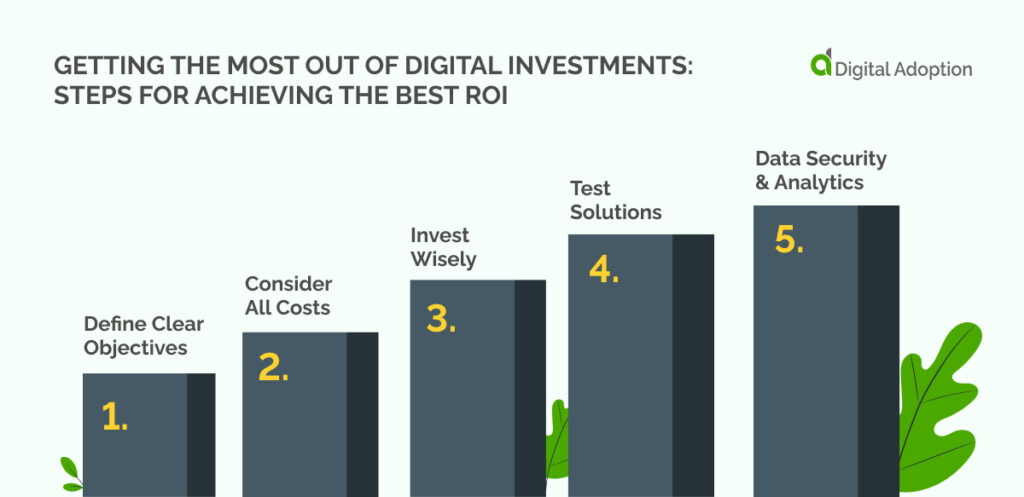
Digital transformation can be a great way to optimize the performance of a business. From increasing efficiency to connecting customers with products and services more easily, it can provide significant cost savings and improved productivity rewards. However, investing in digital transformation is a major commitment that requires careful planning to exploit the most available resources.
Here are some steps that will help businesses get the most out of digital investments:
Define Clear Objectives: Businesses must determine the outcomes they wish to achieve before embarking on any digital transformation project. Draft a plan outlining enterprise objectives and how they will be achieved through digital initiatives such as automation or cloud services. Make sure each objective is SMART (specific, measurable, attainable, results-focused, and time-bound).
Consider All Costs: When making decisions about digital investments, it’s important to factor in all costs associated with implementation, maintenance, and training. Estimate these costs carefully to better understand their impact on ROI (return on investment). Additionally, consider any applicable taxes and fees when making budgeting decisions.
Invest Wisely: It pays to think long-term when investing in digital transformation projects. Don’t just focus on short-term gains — evaluate potential technologies for scalability and longevity to get maximum value from investments over time. Using existing systems or infrastructure as much as possible could help reduce costs while allowing room for experimenting with innovative new technologies without taking too much risk upfront.
Test Solutions: While it may seem tempting to skip testing, this step is essential to success — especially if dealing with large volumes of data or complex systems which require precision execution during deployment. Testing helps identify weaknesses or errors before launch, which could save on costly outages or issues after implementation has already taken place — potentially saving thousands, if not millions, in costly downtime losses for businesses that depend upon uptime for operations or customer satisfaction metrics.
Data Security & Analytics: In order for any digital transformation initiative to succeed, data must remain secure at all times — particularly if deploying systems across multiple platforms or locations — while also being accessible and easy to analyze when needed by decision-makers at all levels within an organization. Ensuring strict security protocols are in place throughout operations while having robust analytics capabilities should prove invaluable when assessing performance against objectives over time and enabling informed decisions regarding future strategies and investments both now & into the future.
The Formula For Digital Transformation ROI
Assessing the ROI of digital transformations can be a complex process, depending on business objectives. Goals could range from increasing brand recognition to more web visits and sales. As such, aligning each digital marketing initiative with these overall aims is essential – once this is done, businesses can accurately assess their success in achieving those desired outcomes.
If businesses want to measure the success of their digital marketing campaigns and ensure they are helping reach goals, tracking leads is one of the best ways. This could include anything from signups for email newsletters to contact forms filled out on the business site. By monitoring these leads, they can determine how effective all these efforts have been.
Gauge the Return on Investment (ROI) of digital campaigns using tools like a digital transformation assessment to look at the number of conversions, such as website visitors who become customers or email subscribers who convert into purchasers.
Fortunately, digital marketing has an enormous advantage over traditional methods because it is extremely measurable. Many tools are accessible to measure progress and results, allowing businesses consistency in adjusting their strategy.
By taking this approach, businesses will ultimately improve digital transformation ROI and be able to identify what works and what doesn’t. This, in turn, will enable them to reduce wasted resources, maximize marketing efforts and grow faster.
A business model such as the AARRR (Acquisition, Activation, Retention, Referral, and Revenue) framework is great for understanding the project performance and the expected return. Business outcomes such as customer lifetime value can also be used to assess digital ROI, allowing businesses to measure the true impact of their campaigns.
What’s Next For Digital Transformation ROI?

In the future, we can expect digital transformation to continue providing significant returns in efficiency, customer engagement, and overall ROI. With this in mind, businesses should be prepared to continually assess their performance and adjust their strategies for the best possible outcomes.
By leveraging customer loyalty, introducing change strategically, targeting ideal customers, and setting expectations early on, organizations will be set up for success with digital transformation. With the right approach, digital ROI can be achieved and sustained in an ever-evolving business landscape.
By optimizing these strategies, businesses can capitalize on the full potential of digital transformation and maximize their ROI.

